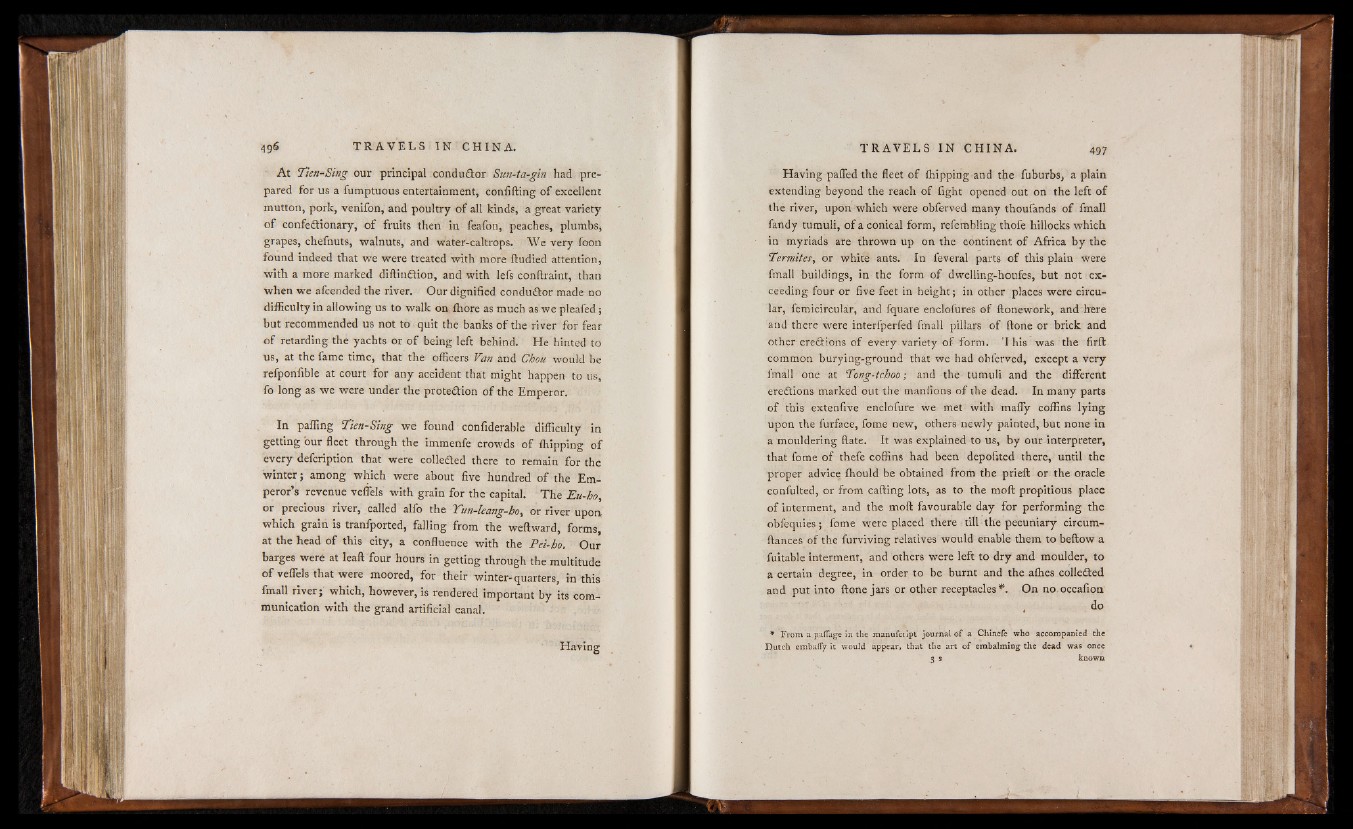
A t Tien-Sing our principal conductor Sun-ta-gin had prepared
for us a fumptuous entertainment, confiding o f excellent
mutton, pork, venifon, and poultry o f all kinds, a great variety
o f confectionary, o f fruits then in feafon, peaches, plumbs,
grapes, chefnuts, walnuts, and water-caltrops. We very foon
found indeed that we were treated with more ftudied attention,
with a more marked diftiuCtion, and with lefs conftraint, than
When we afcended the river. Our dignified conduClor made no
difficulty in allowing us to walk on Ihore as much as we pleafed;
but recommended us not to quit the banks o f the river for fear
o f retarding the yachts or o f being left behind. He hinted to
us, at the fame time, that the officers Van and Chou would be
refponfible at court for any accident that might happen to us,
fo long as we were under the protection o f the Emperor.
In palling Tien-Sing we found confiderable difficulty in
getting bur fleet through the immenfe crowds o f {hipping o f
every defcription that were colleded there to remain for the
winter; among which were about five hundred o f the Emperor’
s revenue veflels with grain for the capital. The Eu-bo,
or precious river, called alfo the Yun-leang-bo, or river upon
which grain is tranfported, falling from the weftward, forms,
at the head o f this city, a confluence with the Pei-bo, Our
barges were at lealt four hours in getting through the multitude
o f veflels that were moored, for their winter-quarters, in this
fmall river; which, however, is rendered important by its communication
with the grand artificial canal.
Having
Having palled the fleet o f flipping and the fuburbs, a plain
extending beyond the reach o f fight opened out on the left of
the river, upon which were obferved many thousands o f fmall
fandy tumuli, o f a conical form, refembling thofe hillocks which
in myriads are thrown up on the continent o f Africa by the
Termites, or white ants. In feveral parts o f this plain were
fmall buildings, in the form o f dwelling-houfes, but not exceeding
four or five feet in height ; in other places were circular,
femicircular, and fquare enclofures o f ftonework, and here
and there were interfperfed fmall pillars o f Hone or brick and
other erections o f every variety o f form. ’I his was the firft
common burying-ground that we had obferved, except a very
imall one at Tong-tchoo; and the tumuli and the different
erections marked out the maniions o f the dead. In many parts
o f this extenfive enclofure we met with maffy coffins lying
upon the furface, fome new, others newly painted, but none in
a mouldering Hate. It was explained to us, by our interpreter,
that fome o f thefe coffins had been depofited there, until the
proper advice ihould be obtained from the prieft or the oracle
confulted, or from calling lots, as to the moll propitious place
o f interment, and the moil favourable day for performing the
obfequies; fome were placed there till the pecuniary circum-
ftances o f the furviving relatives would enable them to bellow a
fuitable interment, and others were left to dry and moulder, to
a certain degree, in order to be burnt and the alhes collected
and put into Hone jars or other receptacles*. On no occafion
< d°
* From a.paflage in the manufcript journal c>F a Chinefe who accompanied the
Dutch embafly it would appear, that the art of embalming the dead was once
. known